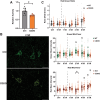Mitochondrial dynamics and quality control regulate proteostasis in neuronal ischemia-reperfusion
- PMID: 40016670
- PMCID: PMC12283014
- DOI: 10.1080/15548627.2025.2472586
Mitochondrial dynamics and quality control regulate proteostasis in neuronal ischemia-reperfusion
Abstract
Mitochondrial damage and dysfunction are hallmarks of neuronal injury during cerebral ischemia-reperfusion (I/R). Critical mitochondrial functions including energy production and cell signaling are perturbed during I/R, often exacerbating damage and contributing to secondary injury. The integrity of the mitochondrial proteome is essential for efficient function. Mitochondrial proteostasis is mediated by the cooperative forces of mitophagy and intramitochondrial proteolysis. The aim of this study was to elucidate the patterns of mitochondrial protein dynamics and their key regulators during an in vitro model of neuronal I/R injury. Utilizing the MitoTimer reporter, we quantified mitochondrial protein oxidation and turnover during I/R injury, highlighting a key point at 2 h reoxygenation for aged/oxidized protein turnover. This turnover was found to be mediated by both LONP1-dependent proteolysis and PRKN/parkin-dependent mitophagy. Additionally, the proteostatic response of neuronal mitochondria is influenced by both mitochondrial fusion and fission machinery. Our findings highlight the involvement of both mitophagy and intramitochondrial proteolysis in the response to I/R injury.Abbreviations: cKO: conditional knockout; CLPP: caseinolytic mitochondrial matrix peptidase proteolytic subunit; DIV: days in vitro; DNM1L/DRP1: dynamin 1 like; ETC: electron transport chain; hR: hours after reoxygenation; I/R: ischemia-reperfusion; LONP1: lon peptidase 1, mitochondrial; mtUPR: mitochondrial unfolded protein response; OGD: oxygen glucose deprivation; OGD/R: oxygen glucose deprivation and reoxygenation; OPA1: OPA1 mitochondrial dynamin like GTPase; PINK1: PTEN induced kinase 1; PRKN: parkin RBR E3 ubiquitin protein ligase; ROI: region of interest; WT: wild-type.
Keywords: Fission; LONP1; PRKN; fusion; mitophagy; neuron.
Conflict of interest statement
No potential conflict of interest was reported by the author(s).
Figures






References
-
- Sanderson TH, Reynolds CA, Kumar R, et al. Molecular mechanisms of ischemia–reperfusion injury in brain: pivotal role of the mitochondrial membrane potential in reactive oxygen species generation. Mol Neurobiol. 2013. Feb;47(1):9–23. doi: 10.1007/s12035-012-8344-z. PMID: 23011809. - DOI - PMC - PubMed
Publication types
MeSH terms
Substances
Grants and funding
LinkOut - more resources
Full Text Sources
Research Materials
Miscellaneous
